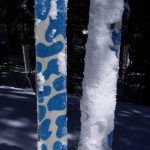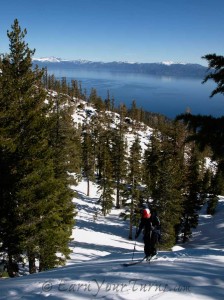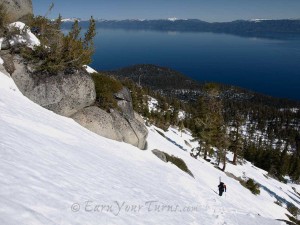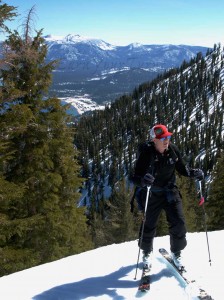Waxing skins is an essential part of taking care of your climbing skins which will also improve their performance. While skins are used for their climbing ability, their ability to glide when sliding between grip modes will help you climb faster. It does so two ways.
Most importantly it can prevent a skin from icing up, which severely hampers glide by creating a rough surface and extra weight. Trying to ascend with iced up skins sucks! By waxing your skins you give them a waterproof coating that helps prevent the fibers from absorbing moisture when the snow is wet. Once they get wet and they come in contact with cold, dry snow, it will freeze to the skin, and then more and more crystals will and soon you’ll have huge globs of snow stuck to the bottom of your skis.
Secondarily, and less noticeable, with the right wax you can increase actual gliding speed and distance on flats or going downhill. You’re less likely to notice the latter benefit, but certainly you can notice the first. So always bring a small bar of wax, and rub it on at the trailhead, tip to tail. It can help you and it won’t hurt you.
This was underscored on my last tour to Tahoe’s west shore recently, all because I forgot a small chunk o’ wax.
Wax Off
It turns out the guy who is letting me practice the craft of boot fitting agreed to go on a ski tour with me. Jim Schaffner is that guy. He’s known for setting up the premier boot fitting service on the West coast, which turned into the Start Haus, a shop that consistently nabs the award for one of the Best Bootfitting Shop in America (since 2004). He comes from many years of involvement in ski racing, from running gates himself to running Salomon’s race department. Olympic caliber skiers routinely use Jim or members of his staff to fine tune their boot fit. I can attest, Start Haus has the tools and Jim remains the champ of fitting problem feet with performance AND comfort.
When I asked where he usually went he replied, “oh, just local stuff, Castle, Donner, Sugar Bowl.”
“Nothing at Tahoe,” I asked, incredulously?
“Nope”
“I know where we’re going.”
At the trailhead I couldn’t find my little bar of wax for waxing the skins. Since we arrived around 8:15am I figured it was best to just get going and hopefully I wouldn’t need it, though I kind of knew that was unlikely.
Before I could break much of a sweat, around the willow zone, we hit our first patch of cold dry snow and if you stood in one place too long, the dry crystals would freeze to the skins wet from the corn snow below. With a bit of technique I could clear the ice off, but it would return, ever more quickly as time wore on.
The alternating warm and wet snow with patches of cold and dry continued even on the upper slopes where the sun was “cookin’ with gas.” When we intersected with an existing skin track, even though it was steeper than I prefer, I took advantage of the plowed road because it allowed me to keep my skins cleared of ice easier.
For awhile that seemed like a good choice. It followed tightly up a ridge, and though I knew it was going to run into a rocky, cliff riddled zone I trusted that the path being blazed would stay useable and the men before us had set a skinable, snow covered path in the spaces between the granite teeth. I had to admit, though it required a climbing peg here and there, they set a pretty good line.
At this point we had been on the trail a full two hours. I was hoping we could top out by then but knew that was unlikely since Schaffner didn’t get out much. However, three hours was realizable and would still allow Jim to get to a meeting by 2 o’clock.Then the path headed up a very steep pitch. In the conditions at hand my skins could hold that steep of a line, but the snow itself would not so I opted to go left and set my own track. This led to a fairly wide path that could be skinned IFF you could do a tight switchback, on a steep slope, reliably. For Jim, with a lot less skinning experience, it was certain to be troublesome and this was definitely a no-fall skin zone.
So I de-skinned and set a boot track. I figured if I set good, closely-spaced steps it would go relatively easier for Jim. But at over 200 pounds he broke through at least half the steps I set, giving him a serious workout of post-holing that took 45 minutes.
We took five at the top of that pitch and discussed whether to continue up or point ’em down and get back to the office.
“It’s only another half hour to the top, but I’m okay with heading down from here too,” I ventured. Jim was tired, but the racer in him couldn’t back down either.
“Ah, if it’s only another half hour, let’s go for it.”
I lied. Well, not exactly. It was definitely less than half an hour away for me, 15 minutes maybe, but I figured Jim could get there in 30 minutes since the angle was easier and the snow grippy. I was wrong.
The good news was the skins no longer were tempted to ice up, and the skiing back down was untracked all the way to the car but we didn’t get there until Jim was supposed to already be in his meeting. Good thing for Jim owners operate under a different set of rules.Ever notice how being late tends to multiply the roadblocks that pop up to keep you from making up time? Enroute to the meeting an additonal detour was required to pick up his son, Jack, from race camp which cost us yet another half hour. We didn’t get back to the Start Haus until after 3pm; it might have been closer to four.
With a bit of wax our skins wouldn’t have iced up, and I would have wound a path up below the rocks, in to the trees where a skin track would be easy to set and follow. No switching modes, or going in to overdrive to deal with post-holing up two or three hundred vert. It still would have taken 3 hours, but the run back would have been faster, he could’ve picked up his son after the meeting and everyone still would have slept well that night. Not to mention the turns back down would have been in buttery corn, with a bit more glide and a lot less glop than in over-cooked Sierra Cement.
Ah, for the want of a little bar of wax.
How To “Wax On”
© 2013





6 comments
Skip to comment form
I wax skins a bit different. I rub the wax from tail to tip first, edging the wax bar deep into the skins to cover more surface area. I then finish by rubbing the bar aggressively from tip to tail. So yes, I go both ways. (-:
What type of wax do you use? Basic ski wax or something specific to skins?
I think it’s important to rub in both directions as Matt indicates (although I just rub vigorously up and down from tip to tail rather than how he does it)- I think the snow starts to stick on the underside of the hairs as it gets jammed in there as you climb so you need wax underneath the hairs too. The hairs look funky at first but flatten right out as you skin. I don’t get any sticking if I have done this at the trailhead before the skins get snow on them (which I admit I don’t always remember to do . . .)
Try the purple colored bdel.com blocks. Once your skins starts gooping up in the field, you may need to take a break and dry your skins out as much as possible, in any way possible, before applying skin wax. Wet skins actually repel the wax. Best to be prepared and rub a bit on the night before. If you apply some wax consistently, you build up a nice layer that just needs a light coat once in a while.
Again the wax seems more anti-gooping than glide-improving. Over forcing your skins to glide over snow is energy sapping at a certain point, so don’t expect anything more than a miniscule increase in speed over your regular skin speed.
I regularly use a universal rub on ski wax that is relevant to the temperature trend of the day. This way, you can also wax your skis or board. Sometimes I will carry skin wax as well. I carry my skin kit (waxes & sharp plastic scraper) in a ziplock bag on all my backcountry outings.
I also use liquid skin wax a couple of times a year. If you develop icing or balling in the BC, first scrape off all the excess snow, then scrape against the skins grain to open up the hairs and remove any ice. If possible let them dry and wax them in both directions.
I do ” hot waxing ” with an iron. I do a fast passing with an iron at 110 or 140 celsius. after rubing with wax . Most of the skimountaineering competitors do this here in Europe for fast gliding